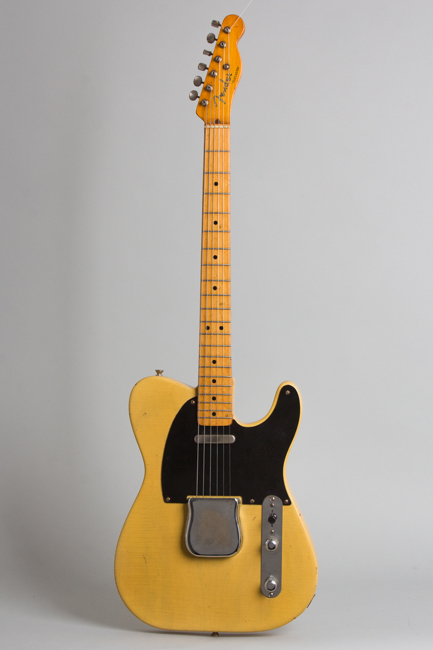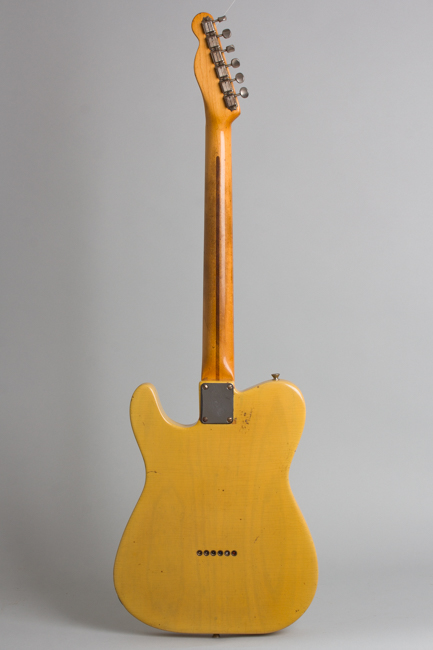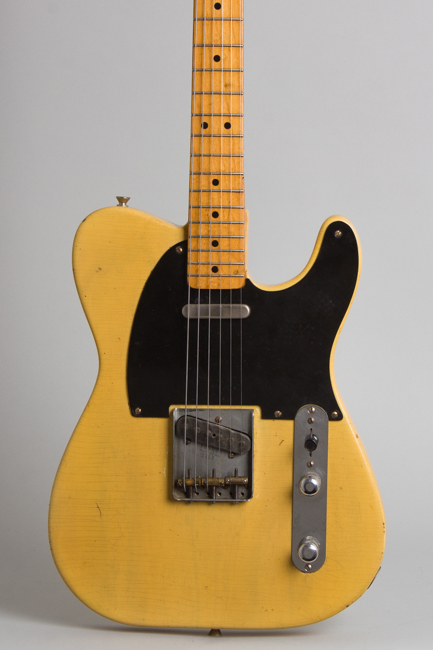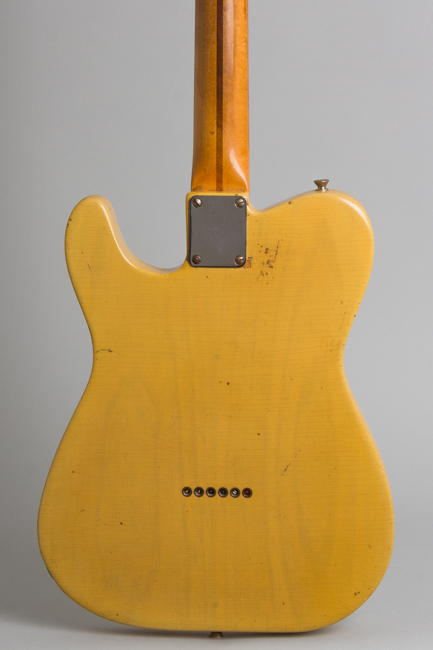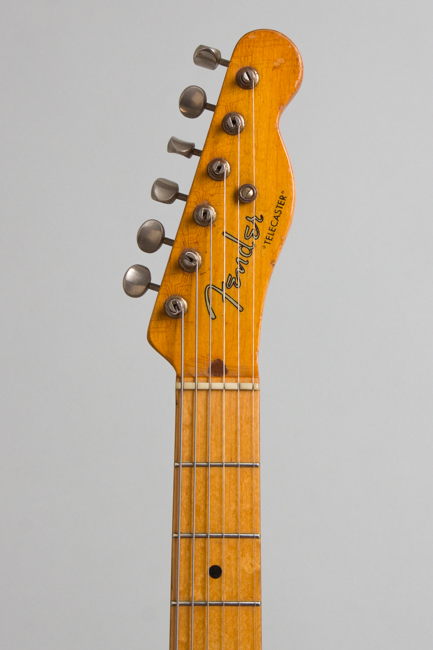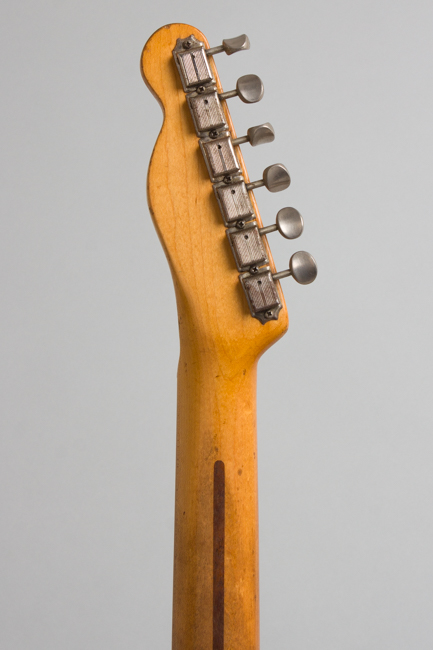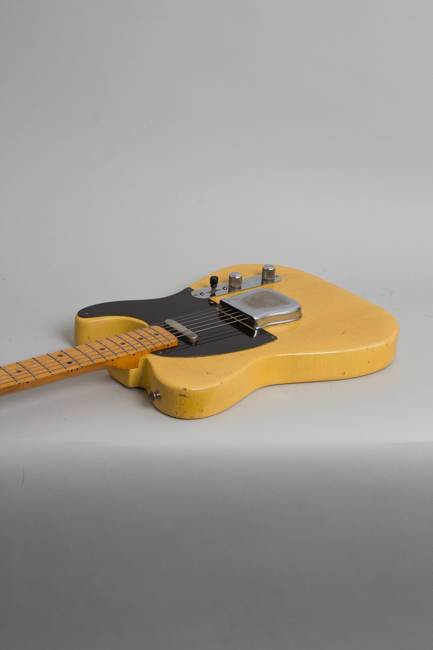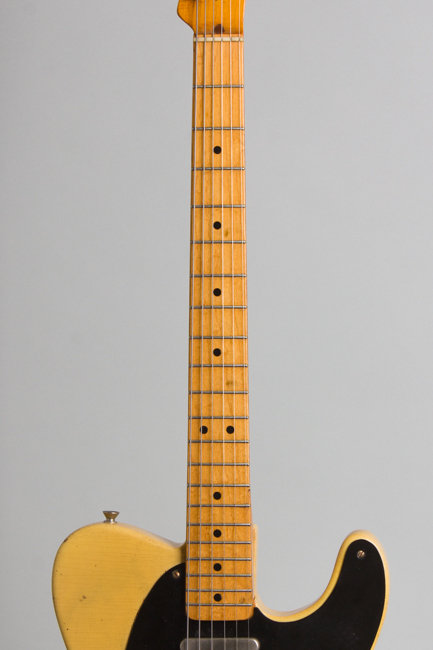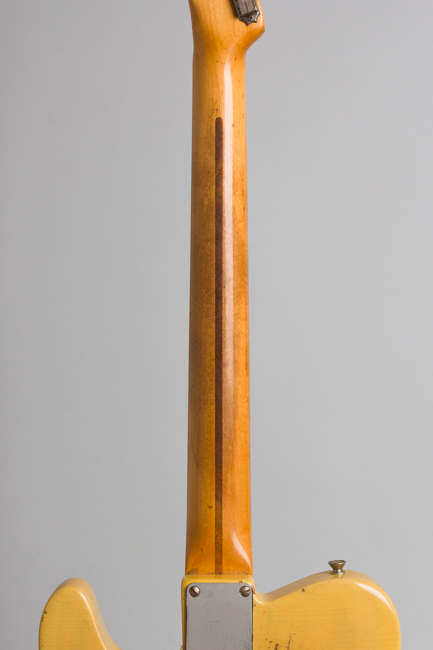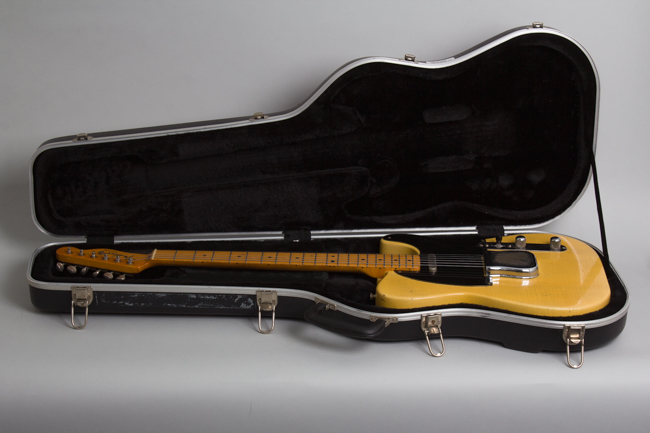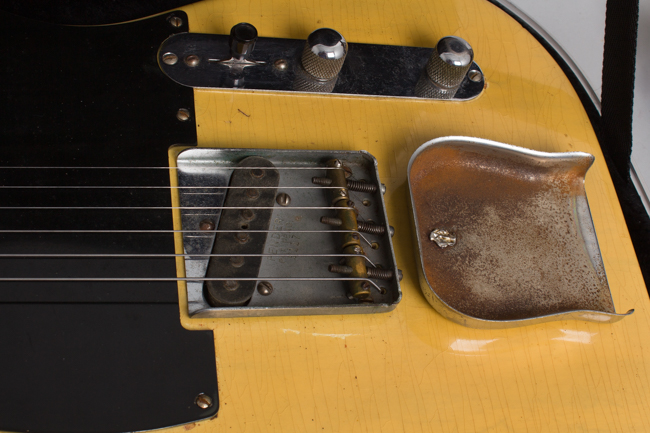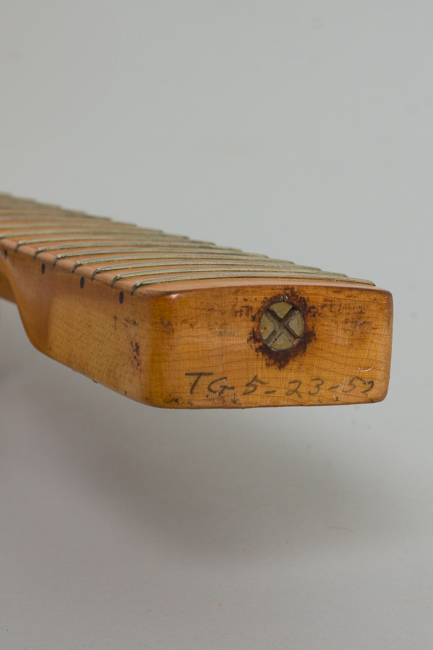Fender Telecaster Solid Body Electric Guitar (1952)
Fender Telecaster Model Solid Body Electric Guitar (1952), made in Fullerton, California, serial # 5117, Blonde lacquer re- finish, ash body, maple neck, molded plastic hard shell case.
This is a veteran example of an original "Blackguard" Telecaster with a refinished body and some relatively modifications along the way but with the original feel and still offering a truly righteous sound. It was built at the company's early cinder-block factory in Fullerton, California in mid-1952. This guitar exhibits classic '52 Tele features: the one-piece maple neck, "butterscotch" blonde ash body, black pickguard, brass bridge saddles, and of course a sound for the ages. This guitar has had the body refinished long ago, a refret with correct style wire and alteration to the modern wiring scheme.
The serial number 5117 is stamped into the bridgeplate. The neck is marked TG 5-23-52 in pencil on the heel; the initials are of Tadeo Gomez, who signed many Fender necks in this period. The body lost any pencil date it might have had during the refinish, but the "D" die stamp is still visible. The neck pickup appears original; the bridge pickup is an authentic period Fender unit from slightly later in the decade, identifiable by the staggered pole pieces; 1952 units have flat poles. This may have been changed early on, as the pickup is quite well-worn. The pots are the original ink-stamped Clarostats but the date codes are soldered over. The pickguard is a cleverly made Bakelite replica likely from a few decades back, authentic looking but not exactly correct.
The cloth wire and electronics rig retain the original components re-wired to the "modern" Telecaster switching scheme and the bass-heavy "mud cap" removed. As originally set up there is was "deep bass" capacitor on the neck pickup in switch position # 1. As currently set up the neck and bridge pickups combine in the middle position, which the original scheme did not allow. This was a very common modification at the time this guitar would have been re-worked.
The very comfortable neck has a nice "C" profile, slimmer than some we have had with a slightly less rounded "throat" in the lower positions; it rounds out beautifully as it approaches the body. The screws are all flat-head types which were already being phased out in mid-1952. Other parts including the tuners, bridgeplate and saddles, control plate, switch tip, knobs and even the snap-on bridge cover remain original.
For many, 1952 is THE classic Telecaster year, with the same look and feel of the earliest Fender Broadcaster and "No-Caster" guitars from 1950-51, but more consistent production standards. '52 is the benchmark year for comparison to all later Fender guitars; Many players and collectors have come to consider the 1952 Telecaster the finest electric guitar ever made -- and one of the most historically important as well.
In his authoritative and beautiful book "The Blackguard", author Nacho Banos references this, calling '52s "a personal favorite" and stating, "The neck feel and lead pickup sounds from these ... make them some of the best Fenders ever made". Early Fender Telecasters of this period are universally considered as one of the most desired of all electric guitars, this one shows typical work performed to working instruments over the years but remains a playing example with a killer sound.
Overall length is 38 3/4 in. (98.4 cm.), 12 5/8 in. (32.1 cm.) wide at lower bout, and 1 3/4 in. (4.4 cm.) in depth, measured at side of rim. Scale length is 25 1/2 in. (648 mm.). Width of nut is 1 5/8 in. (41 mm.).
Overall this is a fine playing guitar if not in original condition, showing fairly extensive work done over the years as noted but retaining the original look and sound of its 1952 Fullerton origins. The body is an older refinish in a fairly authentic looking blonde, with some moderately heavy lateral checking and a decent amount of actual (not "relic'ed") wear. The edges of the body were smoothed out by sanding as is often seen with older refin jobs, more noticeable in some places than others.
The neck has had the fingerboard lightly planed and refretted with correct style wire; the board was shot over entirely with fairly thin lacquer, which also extends as an overspray over the headstock, visible over the original decal and grommets. The back of the neck had the original finish worn to the wood in places, there is a partial old clear overspray which has since been partially worn through again. The bone nut is newer as well.
The pickguard has the correct look but is an older repro piece. The brass bridge saddles and screws have some corrosion and discoloration but nothing is rusted hard and all adjustment screws remain functional. As noted the lead pickup is an original Fender period piece but not original to the guitar. Many of the solder joints have been redone due to the re-wiring to "modern' spec but the internal components remain original. The other hardware remains original even down to the screws and "ashtray" bridge cover.
This instrument retains its original character better than many re-worked Blackguards from this period that were routed, humbuckered and otherwise altered far from this state. It manifests a "Real Relic" look and the sound is still killer, with two well balanced pickups and a truly crackling lead unit. It lives in a later molded plastic HSC that has done some traveling. Overall Very Good Condition.
This is a veteran example of an original "Blackguard" Telecaster with a refinished body and some relatively modifications along the way but with the original feel and still offering a truly righteous sound. It was built at the company's early cinder-block factory in Fullerton, California in mid-1952. This guitar exhibits classic '52 Tele features: the one-piece maple neck, "butterscotch" blonde ash body, black pickguard, brass bridge saddles, and of course a sound for the ages. This guitar has had the body refinished long ago, a refret with correct style wire and alteration to the modern wiring scheme.
The serial number 5117 is stamped into the bridgeplate. The neck is marked TG 5-23-52 in pencil on the heel; the initials are of Tadeo Gomez, who signed many Fender necks in this period. The body lost any pencil date it might have had during the refinish, but the "D" die stamp is still visible. The neck pickup appears original; the bridge pickup is an authentic period Fender unit from slightly later in the decade, identifiable by the staggered pole pieces; 1952 units have flat poles. This may have been changed early on, as the pickup is quite well-worn. The pots are the original ink-stamped Clarostats but the date codes are soldered over. The pickguard is a cleverly made Bakelite replica likely from a few decades back, authentic looking but not exactly correct.
The cloth wire and electronics rig retain the original components re-wired to the "modern" Telecaster switching scheme and the bass-heavy "mud cap" removed. As originally set up there is was "deep bass" capacitor on the neck pickup in switch position # 1. As currently set up the neck and bridge pickups combine in the middle position, which the original scheme did not allow. This was a very common modification at the time this guitar would have been re-worked.
The very comfortable neck has a nice "C" profile, slimmer than some we have had with a slightly less rounded "throat" in the lower positions; it rounds out beautifully as it approaches the body. The screws are all flat-head types which were already being phased out in mid-1952. Other parts including the tuners, bridgeplate and saddles, control plate, switch tip, knobs and even the snap-on bridge cover remain original.
For many, 1952 is THE classic Telecaster year, with the same look and feel of the earliest Fender Broadcaster and "No-Caster" guitars from 1950-51, but more consistent production standards. '52 is the benchmark year for comparison to all later Fender guitars; Many players and collectors have come to consider the 1952 Telecaster the finest electric guitar ever made -- and one of the most historically important as well.
In his authoritative and beautiful book "The Blackguard", author Nacho Banos references this, calling '52s "a personal favorite" and stating, "The neck feel and lead pickup sounds from these ... make them some of the best Fenders ever made". Early Fender Telecasters of this period are universally considered as one of the most desired of all electric guitars, this one shows typical work performed to working instruments over the years but remains a playing example with a killer sound.
Overall length is 38 3/4 in. (98.4 cm.), 12 5/8 in. (32.1 cm.) wide at lower bout, and 1 3/4 in. (4.4 cm.) in depth, measured at side of rim. Scale length is 25 1/2 in. (648 mm.). Width of nut is 1 5/8 in. (41 mm.).
Overall this is a fine playing guitar if not in original condition, showing fairly extensive work done over the years as noted but retaining the original look and sound of its 1952 Fullerton origins. The body is an older refinish in a fairly authentic looking blonde, with some moderately heavy lateral checking and a decent amount of actual (not "relic'ed") wear. The edges of the body were smoothed out by sanding as is often seen with older refin jobs, more noticeable in some places than others.
The neck has had the fingerboard lightly planed and refretted with correct style wire; the board was shot over entirely with fairly thin lacquer, which also extends as an overspray over the headstock, visible over the original decal and grommets. The back of the neck had the original finish worn to the wood in places, there is a partial old clear overspray which has since been partially worn through again. The bone nut is newer as well.
The pickguard has the correct look but is an older repro piece. The brass bridge saddles and screws have some corrosion and discoloration but nothing is rusted hard and all adjustment screws remain functional. As noted the lead pickup is an original Fender period piece but not original to the guitar. Many of the solder joints have been redone due to the re-wiring to "modern' spec but the internal components remain original. The other hardware remains original even down to the screws and "ashtray" bridge cover.
This instrument retains its original character better than many re-worked Blackguards from this period that were routed, humbuckered and otherwise altered far from this state. It manifests a "Real Relic" look and the sound is still killer, with two well balanced pickups and a truly crackling lead unit. It lives in a later molded plastic HSC that has done some traveling. Overall Very Good Condition.
